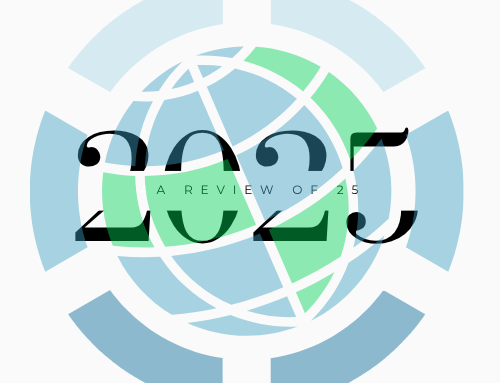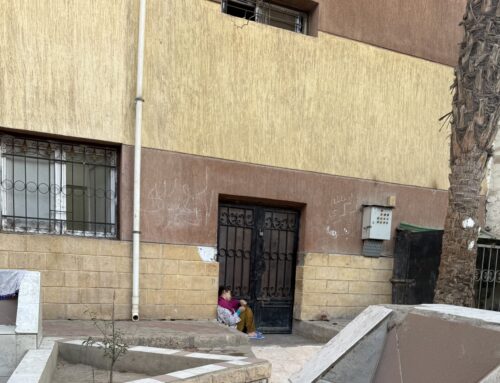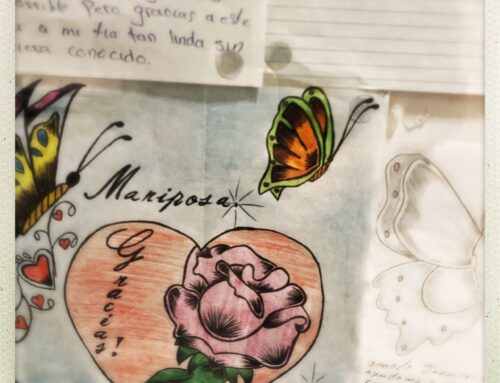AES is pleased to share this interview celebrating our 25th anniversary American Ethnologist article from 2000. Samiri Hernández Hiraldo, visiting assistant professor at Florida Agricultural and Mechanical University, interviews Jorge Duany, professor emeritus at Florida International University, about his article, “Nation on the Move: The Construction of Cultural Identities in Puerto Rico and the Diaspora.”
This interview explores recent changes in migration patterns between Puerto Rico and the United States, major shifts in the racial self-description of Puerto Ricans on the island, and the possible role of religion in reshaping Puerto Rican identities. Hernández Hiraldo and Duany discuss the extraordinary success of the singer and composer Bad Bunny, including the musician’s role advocating for social justice and Puerto Rican cultural pride, and the continuing relevance of the metaphor “nation on the move” to capture the complex identities of Puerto Ricans on the island and abroad.
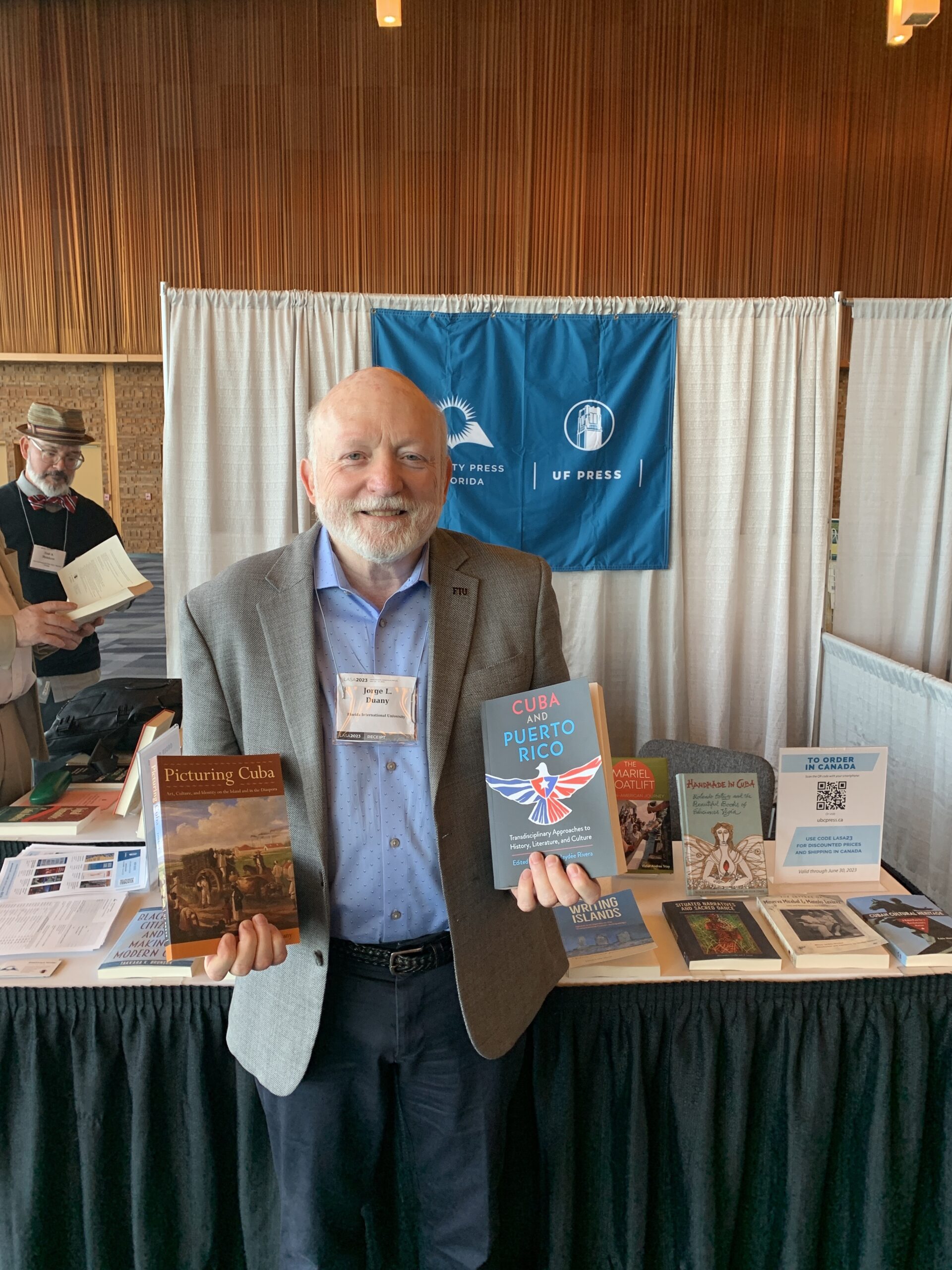
Jorge Duany holding two of his edited volumes at the 2023 congress of the Latin American Studies Association in Vancouver. Photo by Stephanye Hunter
Samiri Hernández Hiraldo: Currently, nearly twice as many Puerto Ricans live in various states across the U.S. as on the island itself. Does this mark a departure from the vaivén you discussed—the cyclical pattern of back-and-forth migration—toward a more dispersed and settled diaspora? To what extent have events such as Hurricane María in 2017, along with ongoing sociopolitical and economic challenges and opportunities, influenced these migration patterns?
Jorge Duany: In 2006, the U.S. Census Bureau estimated that for the first time more persons of Puerto Rican origin were living stateside than on the island. By 2024, 6.1 million people of Puerto Rican ancestry resided in one of the fifty United States, compared to 3.2 million residents of Puerto Rico. The displacement of the Puerto Rican population reached record highs during the second decade of the twenty-first century. According to the census, the contemporary Puerto Rican diaspora has surpassed the “Great Migration” between 1945 and 1964. One of the most notable effects of Puerto Rico’s humanitarian crisis after Hurricane Maria in 2017 was the unprecedented rise in migration to the U.S. mainland. However, for the first time in decades, the census calculated that more people returned to the island than moved abroad between 2018 and 2019. Net migration to the U.S. mainland resumed since 2020.
Given the latter migration patterns, I would argue that Puerto Ricans continue to circulate between the island and various points in the continental United States, although the main direction of the current migrant flow is clearly away from the island. In the last decade, Puerto Rico has faced numerous catastrophic events, including the devastating impact of Hurricanes Maria and Irma, several earthquakes, a prolonged economic recession, a public debt crisis, the collapse of the local power grid and other critical infrastructure, the COVID-19 pandemic, and the imposition of the Financial Oversight and Management Board by the U.S. Congress. These economic and sociopolitical forces have contributed to the island’s depopulation, especially as a result of mass migration.
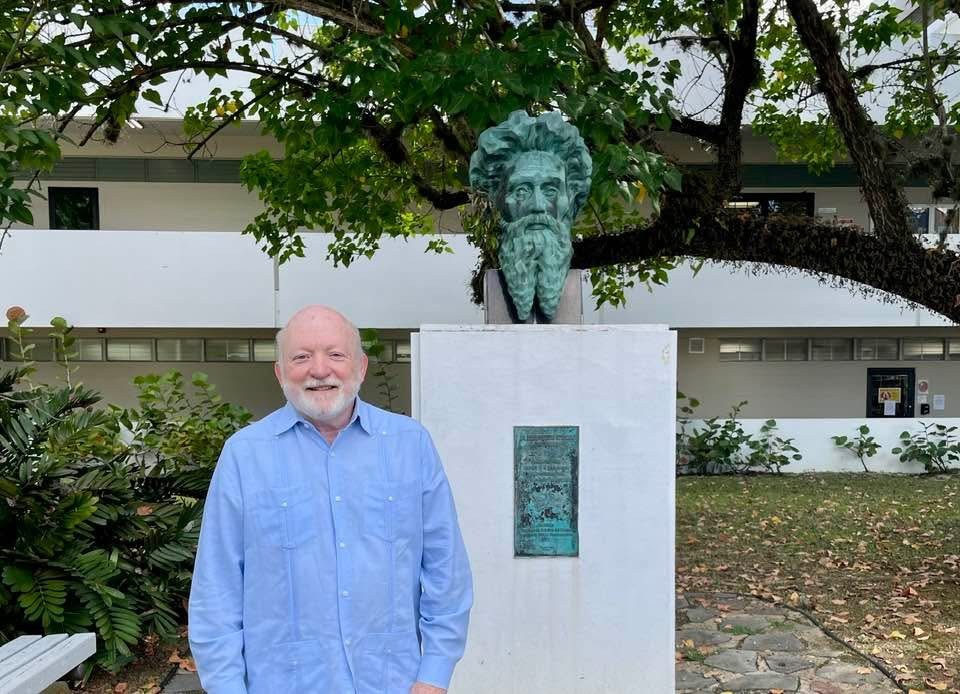
Jorge Duany revisiting the College of Social Sciences of the University of Puerto Rico in Río Piedras, 2023. Photo by Lourdes Duany
Samiri Hernández Hiraldo: According to the Miami Herald (October 12, 2021), the 2000 U.S. Census showed that most Puerto Ricans identified as White, while by 2020, that number had declined significantly. In light of this shift and the increasing visibility of Afro-Puerto Rican identity, are we witnessing a different redefinition or reclaiming of puertorriqueñidad? Initiatives such as the founding of El Centro de Investigación y Archivo Digital en Afrodescendencia (PRAFRO) at the University of Puerto Rico, the Cumbre Internacional de Afrodescendencia (with ties to broader Caribbean and Latin American movements), and the growing celebration of African-rooted music on the island and in the diaspora, all point to a more inclusive and consistent cultural narrative. Still, do you think Blackness is fully recognized within the dominant, mainstream conception of Puerto Rican identity, or does it continue to face marginalization? What implications might this evolving cultural landscape have for long-established immigrant communities in Puerto Rico, such as Cubans, Dominicans, and Haitians, which you have studied, as well as for newer arrivals?
Jorge Duany: Until 2000, official reports appeared to show that Puerto Rico’s population was predominantly of European origin. However, later census data revealed a surprising and dramatic decline in the “White alone” population on the island: from 75.8 percent in 2010 to 17.1 percent in 2020. Furthermore, the share of the inhabitants describing themselves as “some other race alone” or “two or more races” rose rom 11.1 percent in 2010 to 75.3 percent in 2020. Meanwhile, the “Black or African American alone” category decreased from 12.4 percent in 2010 to 7 percent in 2020. Such drastic shifts in the official racial portrait of Puerto Rico have puzzled social researchers, policymakers, community activists, and ordinary citizens.
The long-term effects of the island’s economic downturn, a growing awareness of its African heritage, the imposition of the Financial Oversight and Management Board, and the federal government’s mishandling of disaster recovery after Hurricane Maria may help explain the racial shift between 2010 and 2020. Local grassroots organizations like Colectivo Ilé have also campaigned to encourage island residents to respond “Black” or “Afro-descendant” in the census. In addition, changes in the design and wording of the questionnaire and in the coding of responses and other procedures by the U.S. Census Bureau may have affected the results. Nevertheless, the 2020 census statistics suggest a significant transformation in how Puerto Ricans on the island perceive themselves—no longer identifying primarily as White, but as a racially mixed population.
Despite the growing visibility of people of African origin in popular representations of Puerto Ricanness (puertorriqueñidad), Blackness is not fully recognized as an integral part of national culture, compared to its Spanish and Indigenous “roots.” The official discourse of mestizaje (racial mixture) still hails the harmonious integration between the three main ethnic components of Puerto Rican identity without recognizing the basic inequality of their “encounter.” Racial prejudice and discrimination continue to marginalize people with visible African features, including many Dominican immigrants and their descendants. On the other hand, most Cubans in Puerto Rico, who tend to be of Spanish ancestry, have avoided racial segregation and stigmatization. This racial bifurcation of the island’s largest Caribbean immigrant communities suggests the continuing relevance of racialization in Puerto Rico.
Samiri Hernández Hiraldo: In addition, how has religion shaped the notion of Puerto Rican nationhood over the past twenty years? Could it be that religious morality and human rights discourse, rather than strictly nationalist frameworks, whether Americanized or re-Puerto Ricanized, now serve as the primary political reference for many Puerto Ricans? To what extent do religious affiliations and beliefs influence patterns of migration from the island to the mainland U.S. and beyond?
Jorge Duany: One of the main results of Spanish rule over Puerto Rico for more than four centuries was the establishment of the Catholic Church as the island’s official religion. Today, most Puerto Ricans still identify themselves as Catholic and practice a popular form of religiosity derived from Mediterranean Catholicism, particularly from rural Spain. However, Protestant denominations have increasingly attracted Puerto Ricans since the early twentieth century. By 2014, one-third of the population was Protestant, especially Pentecostal. The diversity of faiths is a hallmark of the contemporary religious landscape of the island, which has probably reshaped the discourse of national identity as well as migration to the U.S. mainland.
Unfortunately, comparatively little research has been conducted on the latter two topics. It is widely known that Puerto Ricans in the United States have a relatively large share of Protestant followers (29 percent according to a 2015 poll). Pentecostal churches have spread rapidly among Puerto Rican migrants and their descendants since the 1940s. More recently, in places like Central Florida, Puerto Rican pastors have established hundreds of evangelical congregations. The significance of religion in contemporary Puerto Rican migration, as well as on the island, merits further study and reflection.
Samiri Hernández Hiraldo: Puerto Rico is undergoing a transformation marked by the growing dominance of English, a tourism-centered economy, a surging real estate market catering to foreign investors, the reassertion of U.S. military presence, and the global ascent of cultural initiatives and icons like Bad Bunny. Bad Bunny embodies a personal vaivén—a back-and-forth motion—not only geographically and in his identity but also in the public discourse he provokes around morality, culture, and economics, often as if suspended in a perpetual cultural tug-of-war. On the island, his influence has only deepened. Through a series of high-production concerts that fuse cutting-edge technology, multimedia art, and collaborations with both local and international artists, Bad Bunny has championed a romanticized yet inclusive vision of Puerto Rican identity—one that consciously embraces gender diversity and reflects a fluid, evolving cultural narrative.
Jorge Duany: Benito Antonio Martínez Ocasio, alias Bad Bunny, has become one of the most popular artists in the world. Considered primarily a Latin trap and reggaetón artist, he also blends elements from a wide range of musical genres such as pop, rock, hip hop, reggae, and R&B. More recently, he has experimented with traditional Puerto Rican genres including plena, bomba, seis, and salsa. He sings and raps with a conversational tone and deep baritone voice, mostly about the well-trodden topics of sex, drugs, alcohol, money, and fame, but often comments on social and political themes, such as the social and economic problems of Puerto Rico, including gentrification and constant power outages. Bad Bunny is also well known for his advocacy of LGBTQ inclusivity and acceptance.
In his most recent records and performances, Bad Bunny has embraced a strong nationalist discourse, advocating for the defense of the Spanish language and local culture, as well as pride and resistance against displacement and cultural assimilation into the U.S. orbit. His meteoric rise to global stardom has captured the imagination of Puerto Rican, Latino, and other audiences, as well as the critical attention of numerous Puerto Rican scholars. His extraordinary commercial success and broad appeal have highlighted the economic plight, musical hybridity, and cultural creativity of Puerto Ricans on the island and in the diaspora.
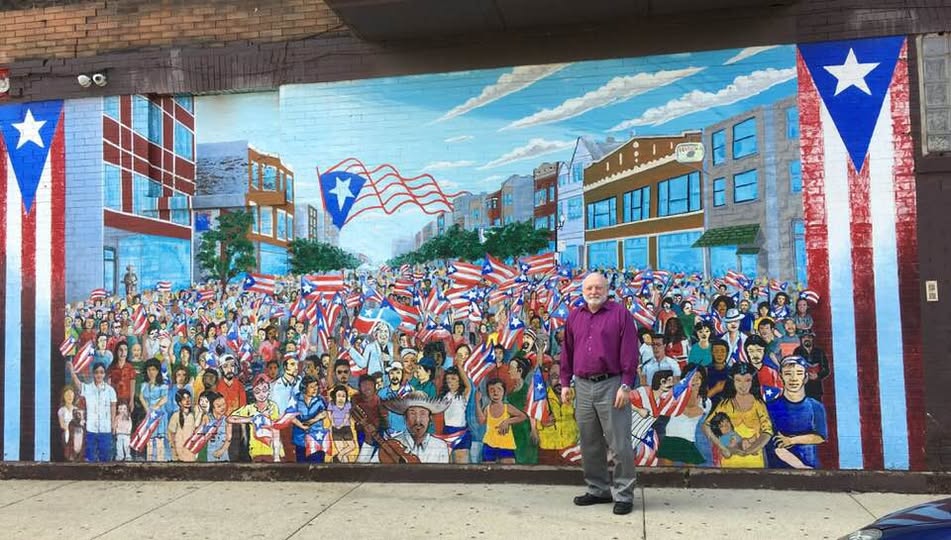
Jorge Duany in front of the street mural, “A Sea of Flags,” by Gamaliel Ramírez, Chicago, 2018. Photo by Jorge Duany Jr.
Samiri Hernández Hiraldo: In light of these shifts, do you think we are witnessing the rise of a new kind of vaivén? One that not only transcends geography and imagination, but increasingly plays out within our relationships, and within the very core of the embodied self? Can it still be called vaivén, or has it evolved into something else—a tension, a pull, a constant stretching in multiple directions at once?
Jorge Duany: When I first used the folk term vaivén (which may well have been in the 2000 American Ethnologist article that we’re now commemorating), I was primarily interested in its reference to the back-and-forth movement of people between Puerto Rico and the United States. (The Spanish term literally means “coming and going,” “swinging,” or “fluctuation”). But I also extended the expression nación en vaivén or “nation on the move” as an apt metaphor for the fluid and hybrid identities of Puerto Ricans on the island and in the diaspora. In this sense, we may now be witnessing a new inflection of vaivén, as you suggest, one that transcends strictly geographic or political definitions of nationhood. The case of Puerto Rico suggests the need to revisit Benedict Anderson’s influential approach to nations as “imagined communities,” as inherently limited and sovereign entities. Puerto Rico has never been an independent country and its massive diaspora makes it difficult to draw neat cultural boundaries between the island and the U.S. mainland. And yet, that hundreds of thousands of Puerto Ricans living on the island and abroad joined Bad Bunny’s recent series of thirty-one concerts, titled “No me quiero ir de aquí” (“I Don’t Want to Leave Here”), should make one rethink the conventional links among place, culture, language, and identity.
Cite as: Hernández Hiraldo, Samiri and Jorge Duany. 2025. “The 25th Anniversary of “Nation on the Move: The Construction of Cultural Identities in Puerto Rico and the Diaspora”. American Ethnologist website, 24 September 2025. [https://americanethnologist.org/online-content/the-25th-anniversary-of-nation-on-the-move-the-construction-of-cultural-identities-in-puerto-rico-and-the-diaspora-by-samiri-hernandez-hiraldo-and-jorge-duany/]
This piece was edited by American Ethnological Society Digital Content Editor Kathryn E. Goldfarb (kathryn.goldfarb@colorado.edu).
